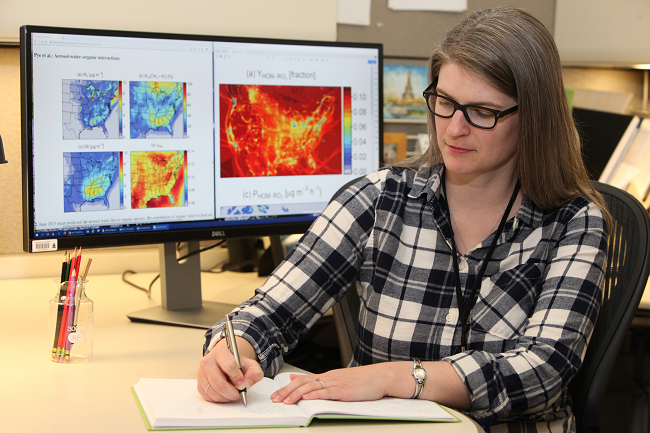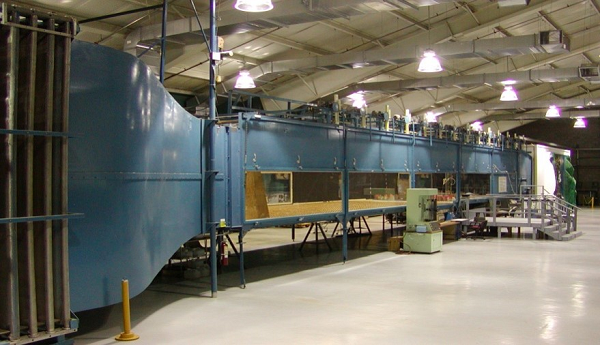Air Quality Modeling
 Researcher studies results from EPA’s Community Multiscale Air Quality Model (CMAQ).Atmospheric modeling is used by air quality managers to make decisions on effective and efficient ways to implement the National Ambient Air Quality Standards (NAAQS) and improve air quality. EPA has an extensive air quality modeling program that develops, evaluates, and applies models to support a wide variety of air quality management needs.
Researcher studies results from EPA’s Community Multiscale Air Quality Model (CMAQ).Atmospheric modeling is used by air quality managers to make decisions on effective and efficient ways to implement the National Ambient Air Quality Standards (NAAQS) and improve air quality. EPA has an extensive air quality modeling program that develops, evaluates, and applies models to support a wide variety of air quality management needs.
Advances in modeling enables users to better estimate the relationship between sources of pollution and their effects on ambient air quality, predict the impacts from potential emission sources, and simulate ambient pollution concentrations under different policy scenarios. They are critical for determining the relative contributions from different sources, monitoring compliance of air quality regulations, and making policy decisions.
This research is also enhancing the ability to conduct multipollutant air quality assessments at local, regional, national, and global scales in addition to developing multimedia and multi-stressor models to address complex environmental issues. The research objectives are:
- Characterize the role of background air pollution on NAAQS attainment and implementation
- Support the development of major energy and transportation sector rules
- Inform air quality permitting decisions
- Assess risks posed by criteria and hazardous air pollutants (HAPs)
- Develop local and regional-scale air quality and related climate data
Related Links:
On this page:
- Community Multiscale Air Quality (CMAQ) Modeling System
- Air Dispersion Modeling
- Indoor Air Modeling
- Chemical Mechanisms to Address New Challenges in Air Quality Modeling
- Multi-media and Multi-stressor Modeling
-
Modeling SARS-CoV-2 Aerosols and Evaluating Ways to Inactivate Aerosolized SARS-CoV-2
Community Multiscale Air Quality (CMAQ) Modeling System
 The Community Multiscale Air Quality (CMAQ) Modeling System is EPA’s premier modeling system for studying air pollution from local to hemispheric scales. For more than two decades, EPA and states have used CMAQ to translate fundamental atmospheric science principles to policy scenarios to support air quality management decisions. CMAQ is continually updated to incorporate knowledge on the state-of-the science and harness high performance computing power to more effectively and efficiently characterize air quality and protect human health and the environment.
The Community Multiscale Air Quality (CMAQ) Modeling System is EPA’s premier modeling system for studying air pollution from local to hemispheric scales. For more than two decades, EPA and states have used CMAQ to translate fundamental atmospheric science principles to policy scenarios to support air quality management decisions. CMAQ is continually updated to incorporate knowledge on the state-of-the science and harness high performance computing power to more effectively and efficiently characterize air quality and protect human health and the environment.
CMAQ combines meteorological, emissions, and air chemistry transport and deposition models to explore the estimated short- and long-term impacts of different policy and regulatory options, including actions to attain the NAAQS, and long-term impacts of the changing environment. Developed and maintained by EPA scientists, the CMAQ modeling system continues to evolve to better represent how complex mixtures of air pollutants are formed, transported, and eventually removed from the atmosphere.
Researchers lead efforts to conduct and apply fundamental physical science that improves CMAQ’s representation of complex atmospheric chemistry and dynamics pertinent to emerging problems and contaminants. A global user community has fostered collaborations with state, federal, industrial, and academic institutions in the United States and around the world to assess and improve the model’s functionality.
Currently, CMAQ developers are broadening the model’s scope to enhance its ability to consider atmospheric phenomena from the global scale to the neighborhood scale. These efforts are important for understanding the impacts of human activities and intervention strategies at all levels., including the impacts of agricultural sources such as animal feeding operations (AFOs).
Related Links:
- CMAQ: The Community Multiscale Air Quality Modeling System
- Science Matters: EPA Model Shows Potential in Unraveling the Mystery of Lightning’s Impact on Air Quality
- Science Matters: The Legacy of EPA's Acid Rain Research
Air Dispersion Modeling
 Studies are conducted in the meteorological wind tunnel at the Fluid Modeling Facility in Research Triangle Park, North Carolina.Air quality dispersion models predict the impact of pollutants released from various sources such as power plants and roadways. The models are used by EPA, states, tribes and local agencies to assess control strategies, regulate emissions, and evaluate mitigation options, particularly during the planning and permitting phases of projects.
Studies are conducted in the meteorological wind tunnel at the Fluid Modeling Facility in Research Triangle Park, North Carolina.Air quality dispersion models predict the impact of pollutants released from various sources such as power plants and roadways. The models are used by EPA, states, tribes and local agencies to assess control strategies, regulate emissions, and evaluate mitigation options, particularly during the planning and permitting phases of projects.
EPA researchers, in collaboration with other scientists, developed the Air Quality Dispersion Model (AERMOD), which is the Agency-preferred and recommended dispersion modeling system used today. AERMOD is used to model the impact on air quality from sources that emit a variety of pollutants regulated by the EPA, including carbon monoxide, lead, sulfur dioxide, nitrogen dioxide and primary particulate matter; and hazardous air pollutants, also known as air toxics.
Research continues to provide updates to the model. To improve modeling capability, there is a need for more information on the influence that buildings, roadways and other structures have on the flow and dispersion of air pollution. Researchers are leading efforts to develop data sets and algorithms to improve air dispersion modeling simulations to better capture these near-source effects.
Studies are conducted in the meteorological wind tunnel at the Fluid Modeling Facility in Research Triangle Park, North Carolina, and in the field. The tunnel is large enough to simulate pollution dispersion of a scaled replica of a building, power plant or other object of interest and surrounding topography. The tunnel has a large test section measuring 3.65 meters across and 2.1 meters tall and provides an extensive downwind distance over which to study the development of a plume emitted from a source.
Current projects include studies of the potential of noise barriers for pollution mitigation in the near-road environment, and studies of the role of urban structures on flow and dispersion.
Related Links:
- Air Quality Dispersion Modeling (AERMOD)
- Research on Near Roadway and Other Near Source Air Pollution
Indoor Air Modeling
Estimation of emissions, fate and transport of indoor air pollutants is an essential part of multi-pathway exposure assessment since most people spend a large portion of their time indoors. Indoor air modeling plays an important role in indoor air research because laboratory and field testing is costly, time-consuming and technically challenging to appropriately characterize chemicals in a broad range of indoor environments.
Researchers at EPA have developed indoor air modeling programs to assist with understanding indoor air pollution. They include:
- Simulation Tool Kit for Indoor Air Quality and Inhalation Exposure (IAQX)
- Indoor Semi-volatile Organic Compounds (iSVOC)
- Parameters (PARAMS) Program Version 1.1 for indoor emission source modeling
These programs are Microsoft Windows-based and user friendly. PARAMS implements 30 methods for estimating the parameters in indoor emissions source models, which are an essential component of indoor air quality and exposure models. IAQX and iSVOC are used for dynamic modeling of the emissions, transport, and absorption of pollutants in the indoor environment. They can be used as a front-end component for stochastic exposure models and provide estimates of the pollutant’s distributions in indoor media in the absence of experimental measurements.
IAQX consists of five stand-alone simulation programs. A general-purpose simulation program performs multi-zone, multipollutant simulations and allows gas-phase chemical reactions. The other four programs implement fundamentally based models for special purposes. In addition to performing conventional indoor air quality simulations, which compute the time concentration profile and inhalation exposure, IAQX can estimate the adequate ventilation rate when certain air quality criteria are provided by the user, a unique feature useful for product stewardship and risk management.
The i-SVOC program estimates the emissions, transport, and absorption of semivolatile organic compounds (SVOCs) in the indoor environment as functions of time when a series of initial conditions are given. The program covers six types of indoor compartments: air (gas phase), air (particle phase), sources, sinks (i.e., absorption by interior surfaces), contaminant barriers, and settled dust. The key input parameters of the program include the solid-air partition coefficients, solid-phase diffusion coefficients, and gas-phase mass transfer coefficients.
Using these indoor air modeling programs, scientists can gain a deeper understanding of the hazards and risks of many chemicals. The results will support EPA, states, tribes and local agencies with refining existing risk assessments and making policy decisions to minimize exposure and protect human health and the environment from thousands of existing and emerging chemicals indoors.
Related Links:
- Simulation Tool Kit for Indoor Air Quality and Inhalation Exposure (IAQX)
- Indoor Semi-volatile Organic Compounds (iSVOC)
- Parameters (PARAMS) Program Version 1.1 for indoor emission source modeling
Chemical Mechanisms to Address New Challenges in Air Quality Modeling 
In 2020, EPA awarded nine Science to Achieve Results (STAR) grants to conduct research to improve air quality models by providing a better representation of atmospheric chemical reactions, which is known as chemical mechanisms. These chemical reactions are relevant to the chemical transformation of air pollutants, such as ozone, particulate matter (PM) and air toxics, which can cause adverse human health and environmental effects.
New insights on atmospheric chemistry and advancement in chemical mechanisms will improve air quality model predictions, which may inform the development of more effective strategies for improving air quality. The project period for the grants is August 1, 2020 to July 31, 2023.
Many chemical mechanisms currently used in multi-pollutant air quality models were originally developed when air quality management and scientific studies focused on extreme pollution episodes in urban areas. Since the early 1990s, pollutant emissions from many man-made sources have declined substantially, and the National Ambient Air Quality Standards (NAAQS) have been made more protective. Today, studies show some emission sources previously considered insignificant, require further scientific evaluation, and new chemical compounds are emerging as important contributors to air quality concerns.
Additional chemical mechanism research is needed to understand these and other air quality issues.
The research objectives for these grants are:
- Development of state-of-the-science chemical mechanisms that can be easily updated to reflect evolving scientific understanding
- Development and evaluation of algorithms, numerical techniques and software tools to simplify detailed chemical mechanisms into application-specific condensed (i.e., simplified) mechanisms appropriate for use in air quality models
- Applying newly developed chemical mechanisms in air quality models to investigate air quality issues relevant to the United States
Related Links:
- Chemical Mechanisms to Address New Challenges in Air Quality Modeling Grants
- Overview Information
- EPA Air Modeling Research
Multi-Media and Multi-Stressor Modeling
The natural world that consists of our atmosphere, land, water, and ecosystems is interconnected in many ways. Because of this connectivity, when a contaminant or pollutant is introduced into the environment, there can be a cascade of multiple impacts.
Many of the nation’s environmental problems require an understanding of how contaminants move across air, land and water and how they may transform. For example, deposition of gases and particles from the atmosphere to the water and land surfaces results in acidification and eutrophication, which, in turn, impacts the abundance and diversity of aquatic species. In another related case, excessive nitrogen (N) and phosphorus (P) concentrations in surface water, resulting from flooding, runoff or atmospheric deposition, contribute to harmful algal blooms. This can be accelerated by increased water temperatures and lead to large oxygen depleted zones or hypoxia and the loss of marine life and biodiversity.
EPA scientists work to understand the interconnectedness of the environment across media by collecting and evaluating observations (e.g. pollutant concentrations in various media, dissolved oxygen levels, etc.) and developing, evaluating and applying multi-media modeling tools. The modeling enables simulation of the transport and transformation of chemicals through different media (e.g. air, water, soil) to provide data that can be used to address environmental challenges such as acid rain, nitrogen deposition and other environmental problems. One research priority is to characterize the nitrogen cycle, which requires knowledge of many atmospheric, soil and plant processes.
Multi-media models are used to characterize nitrogen loading to watersheds such as the Chesapeake Bay and Albemarle-Pamlico estuaries and the Nooksack River Basin and are also used to evaluate nitrogen exceedances for terrestrial ecosystems.
Scientists are developing a coupled modeling system that includes exchange processes between existing air quality, meteorology, hydrology, and water temperature models to identify hotspots of high-water temperatures areas, which are correlated to high-nutrient loads in the Mississippi River Basin. They are also developing a high temporal (daily) and spatial (30-100 meters) distributed modeling system to simulate nitrogen yields from agricultural land use, as well as atmospheric deposition loads.
In another project using meteorological and hydrology modeling, scientists are exploring methods of projecting the risks to ecosystems and stormwater management from changes in extreme rainfall. These and other studies on multi-media modeling and measurements are improving the ability to simulate the potential impacts of pollutants across time and space.
Related Links:
Modeling SARS-CoV-2 Aerosols and Evaluating Ways to Inactivate Aerosolized SARS-CoV-2
EPA researchers are studying SARS-CoV-2 aerosols including fate and transport in an office environment, in a mass transit setting, and evaluating potential aerosol disinfection device technologies in various scenarios.
Related Links:
